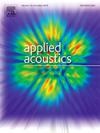The artificial rabbits optimized variational mode decomposition and its application on quality evaluation of machines
IF 3.4
2区 物理与天体物理
Q1 ACOUSTICS
引用次数: 0
Abstract
In order to distinguish the imperceptible differences of vibration and noise signals existing among a large amount of the eligible machinery of complex structures, a new feature extraction method, the artificial rabbits optimized variational mode decomposition (ARO-VMD), is proposed and applied to the quality evaluation of machines. Firstly, the ARO-VMD adaptively determinate the number of decomposition modes with three steps: preprocessing the original signal with generalized minimax-concave penalty function to remove the interference of irrelevant components, implementing adaptive extraction of penalty factors with a new fitness function obtained by ARO algorithm, and Tanimoto coefficient being applied as the judging condition to stop decomposition. Secondly, the integrated timbre parameter (ITP) is constructed based on the correlation analysis of the timbre parameters of the extracted signal components. Finally, the least squares support vector regression optimized by the ARO is used to evaluate the quality of the machine. The feasibility and superiority of the ARO-VMD method were verified by comparative analysis, and the accuracy of the quality evaluation model proposed was 95.65% on the verification over the industrial sewing machines, where the ITP have the highest correlation with quality evaluation results.
求助全文
约1分钟内获得全文
求助全文
来源期刊

Applied Acoustics
物理-声学
CiteScore
7.40
自引率
11.80%
发文量
618
审稿时长
7.5 months
期刊介绍:
Since its launch in 1968, Applied Acoustics has been publishing high quality research papers providing state-of-the-art coverage of research findings for engineers and scientists involved in applications of acoustics in the widest sense.
Applied Acoustics looks not only at recent developments in the understanding of acoustics but also at ways of exploiting that understanding. The Journal aims to encourage the exchange of practical experience through publication and in so doing creates a fund of technological information that can be used for solving related problems. The presentation of information in graphical or tabular form is especially encouraged. If a report of a mathematical development is a necessary part of a paper it is important to ensure that it is there only as an integral part of a practical solution to a problem and is supported by data. Applied Acoustics encourages the exchange of practical experience in the following ways: • Complete Papers • Short Technical Notes • Review Articles; and thereby provides a wealth of technological information that can be used to solve related problems.
Manuscripts that address all fields of applications of acoustics ranging from medicine and NDT to the environment and buildings are welcome.
 求助内容:
求助内容: 应助结果提醒方式:
应助结果提醒方式:


